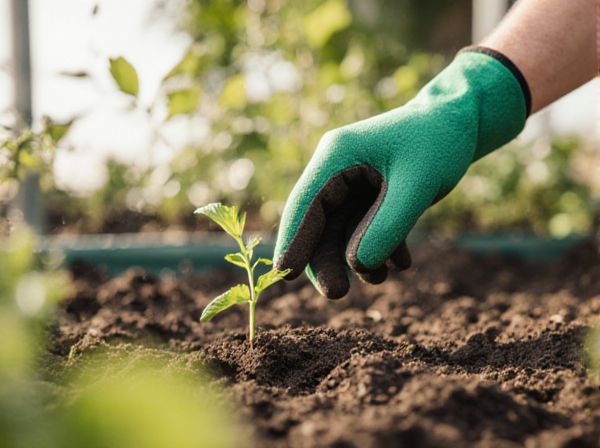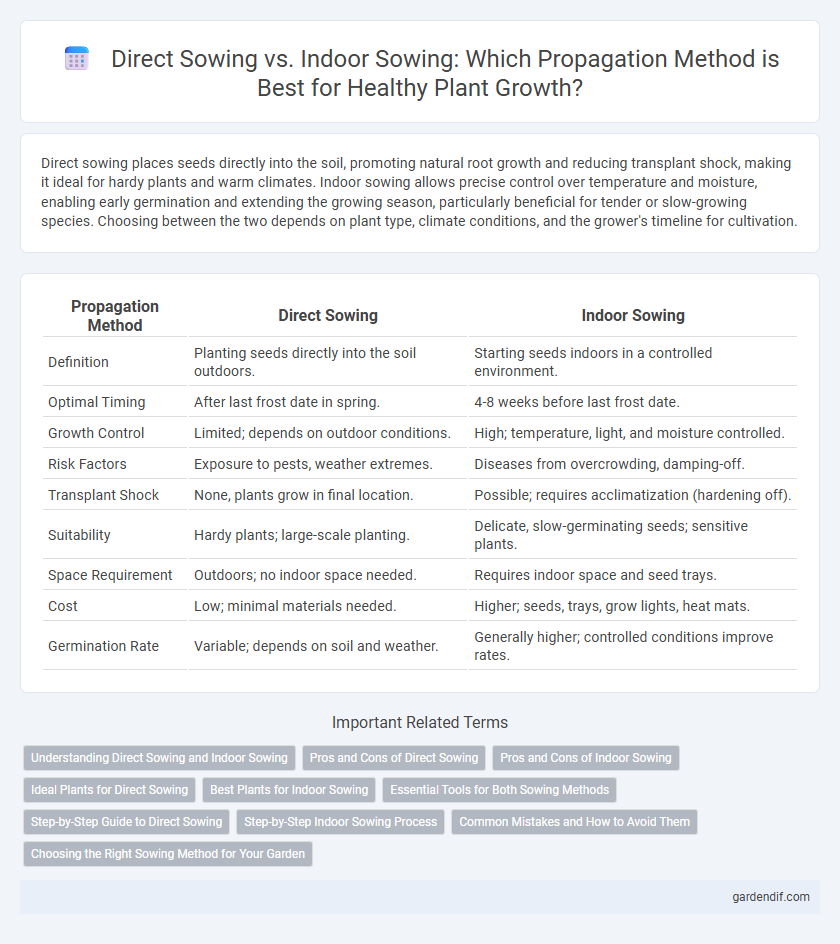
Direct Sowing vs Indoor Sowing Illustration
Direct sowing places seeds directly into the soil, promoting natural root growth and reducing transplant shock, making it ideal for hardy plants and warm climates. Indoor sowing allows precise control over temperature and moisture, enabling early germination and extending the growing season, particularly beneficial for tender or slow-growing species. Choosing between the two depends on plant type, climate conditions, and the grower's timeline for cultivation.
Table of Comparison
| Propagation Method | Direct Sowing | Indoor Sowing |
|---|---|---|
| Definition | Planting seeds directly into the soil outdoors. | Starting seeds indoors in a controlled environment. |
| Optimal Timing | After last frost date in spring. | 4-8 weeks before last frost date. |
| Growth Control | Limited; depends on outdoor conditions. | High; temperature, light, and moisture controlled. |
| Risk Factors | Exposure to pests, weather extremes. | Diseases from overcrowding, damping-off. |
| Transplant Shock | None, plants grow in final location. | Possible; requires acclimatization (hardening off). |
| Suitability | Hardy plants; large-scale planting. | Delicate, slow-germinating seeds; sensitive plants. |
| Space Requirement | Outdoors; no indoor space needed. | Requires indoor space and seed trays. |
| Cost | Low; minimal materials needed. | Higher; seeds, trays, grow lights, heat mats. |
| Germination Rate | Variable; depends on soil and weather. | Generally higher; controlled conditions improve rates. |
Understanding Direct Sowing and Indoor Sowing
Direct sowing involves planting seeds directly into the soil where they will grow, offering natural root development and reduced transplant shock. Indoor sowing takes place in controlled environments, enabling precise temperature and moisture management for improved germination rates and early seedling growth. Comparing both methods, direct sowing is ideal for hardy crops with longer growing seasons, while indoor sowing benefits tender plants that require protection from adverse weather conditions.
Pros and Cons of Direct Sowing
Direct sowing offers the advantage of lower initial costs and reduced transplant shock since seeds germinate and grow in their natural environment, promoting stronger root systems. However, it is more vulnerable to environmental variables such as soil temperature fluctuations, pests, and inconsistent moisture levels, which can lead to uneven germination and lower plant survival rates. This method also limits the growing season flexibility compared to indoor sowing, where controlled conditions enable earlier seedling development.
Pros and Cons of Indoor Sowing
Indoor sowing offers controlled environmental conditions that enhance seed germination rates and extend the growing season by protecting seedlings from harsh weather and pests. However, it requires additional resources such as artificial lighting, temperature regulation, and careful monitoring, which can increase costs and labor. While indoor sowing promotes early plant development and better seedling management, transplant shock risk remains when moving plants outdoors.
Ideal Plants for Direct Sowing
Ideal plants for direct sowing include root vegetables like carrots and radishes, as well as hardy herbs such as cilantro and dill, which thrive when sown directly into the soil. These species typically require minimal transplant shock and benefit from the natural soil environment to develop strong root systems. Cold-tolerant crops like peas and spinach also perform well with direct sowing, enabling early germination and growth in outdoor conditions.
Best Plants for Indoor Sowing
Indoor sowing is ideal for plants like tomatoes, peppers, and basil, which require controlled temperature and consistent moisture levels for optimal germination. Herbs such as mint, chives, and parsley also thrive when started indoors due to their delicate seed structure and need for stable conditions. These plants benefit from indoor propagation techniques that protect young seedlings from pests and harsh weather, ensuring stronger, healthier growth before transplanting outdoors.
Essential Tools for Both Sowing Methods
Essential tools for direct sowing include a quality seed drill or hand-held seeder, a garden trowel or hoe for soil preparation, and a watering can or hose with a fine spray nozzle to ensure gentle irrigation. Indoor sowing requires seed trays or pots with drainage holes, a sterile seed-starting mix to promote healthy germination, grow lights or a sunny windowsill for consistent light exposure, and a humidity dome or plastic cover to maintain moisture levels. Both methods benefit from a soil thermometer to monitor temperature and labels to track plant varieties and sowing dates accurately.
Step-by-Step Guide to Direct Sowing
Direct sowing involves planting seeds directly into prepared outdoor soil, maximizing natural growth conditions for robust seedlings. Start by selecting a sunny site with well-draining soil, then prepare the soil by loosening it and removing weeds to ensure optimal seed contact. Sow seeds at the recommended depth and spacing, cover lightly with soil, water gently, and monitor regularly for germination and weed control to achieve healthy plant establishment.
Step-by-Step Indoor Sowing Process
Indoor sowing begins by selecting high-quality seeds and sterilizing the planting medium to prevent fungal diseases. Seeds are sown evenly in trays filled with moist, well-draining soil, then covered lightly and maintained at optimal temperature and humidity levels using a propagation dome or heated mat. Regular monitoring for moisture, light exposure, and air circulation ensures strong germination and healthy seedling development before transplanting outdoors.
Common Mistakes and How to Avoid Them
Common mistakes in direct sowing include planting seeds too deep or too shallow, leading to poor germination rates and weak seedlings; to avoid this, follow seed packet depth recommendations and ensure soil is well-prepared with adequate moisture. Indoor sowing errors often involve overwatering or insufficient light, causing damping-off disease or leggy seedlings; using sterile seed trays, proper drainage, and placing seedlings under grow lights or near sunny windows helps prevent these issues. Careful monitoring of temperature and humidity in both methods enhances seedling health and improves propagation success.
Choosing the Right Sowing Method for Your Garden
Direct sowing allows seeds to be planted straight into the garden soil, making it ideal for hardy plants that thrive in natural conditions and mature quickly. Indoor sowing provides a controlled environment for delicate or slow-germinating seeds, ensuring higher success rates for seedlings before transplanting outdoors. Selecting the right method depends on plant type, climate, and growing season length, maximizing germination and overall garden productivity.
Direct Sowing vs Indoor Sowing Infographic

 gardendif.com
gardendif.com